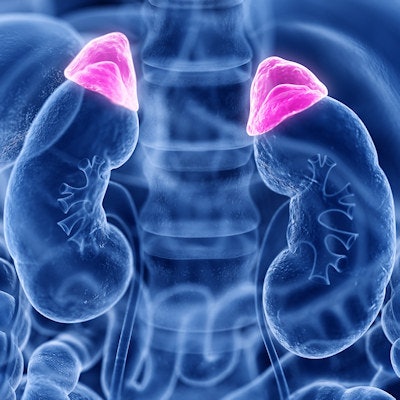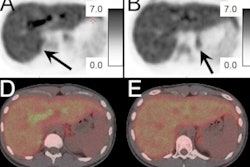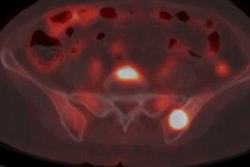
Gallium-68 (Ga-68) pentixafor PET/CT imaging may be a promising noninvasive approach for subtyping patients with primary aldosteronism, according to a study published February 16 in JAMA Network Open.
Researchers led by Dr. Jinbo Hu, PhD, of the First Affiliated Hospital of Chongqing Medical University in Chongqing, China, found that Ga-68 pentixafor PET/CT was highly accurate for diagnosing primary aldosteronism and suggest the approach could be an alternative to invasive adrenal vein sampling (AVS).
"Considering the universal need for safe, accurate, and noninvasive alternatives to AVS, gallium-68 pentixafor PET-CT may represent a novel and promising tool for [primary aldosteronism] subtyping," Hu and colleagues wrote.
Primary aldosteronism (PA) is a disorder in which the adrenal glands make too much aldosterone, which can cause high blood pressure and increase the risk of heart disease and stroke. AVS is the recommended procedure for subtyping primary aldosteronism (PA) into its two main types, unilateral PA (UPA) or bilateral PA (BPA), which require different treatments: minimally invasive surgery for UPA and medication for BPA.
However, AVS is invasive and technically difficult, and subtyping PA noninvasively is currently a great challenge, according to the researchers.
Pentixafor is a ligand developed in 2015 to bind to receptors called CXCR4 on the surface of cells. When combined with the nuclear isotope Ga-68, the resulting radiotracer can reveal abnormal CXCR4 activity on PET imaging. The approach has been widely used in cancer imaging, yet a recent case series suggests it may also be useful in patients with PA, the researchers noted.
To explore these early findings further, the group tested Ga-68 pentixafor PET/CT in a group of 100 patients diagnosed with PA. Patients underwent imaging between November 2021 and May 2022, with results in subtyping PA compared to AVS as a reference standard.
Among the 100 patients, 43 had UPA and 57 had BPA. The analysis revealed a good diagnostic accuracy of Ga-68 pentixafor PET/CT in differentiating the two subtypes, according to the findings.
Ga-68 pentixafor PET/CT was concordant with AVS outcomes in 90% of patients, and the concordance rate increased to 100% among patients with unilateral adrenal nodules greater than 10 mm in diameter on CT, the researchers found.
In addition, however, in patients without a typical unilateral nodule, the sensitivity of PET imaging decreased, suggesting a limited spatial resolution of the approach, they wrote.
"These findings suggest that gallium-68 pentixafor PET-CT may be a useful subtyping diagnostic method in some patients with PA," the group wrote.
Ultimately, the strengths of the study included its prospective design and the use of a rigorous protocol for the diagnosis and subtyping of PA, according to the group. More than half of patients enrolled in the study had BPA, which is close to the subtype distribution found clinically, and this supports the use of the method in patients with both subtypes, the authors suggested.
"Although this approach may not fully replace AVS, it may be associated with a substantially reduced number of AVS procedures required for selected patients," Hu and colleagues concluded.



















